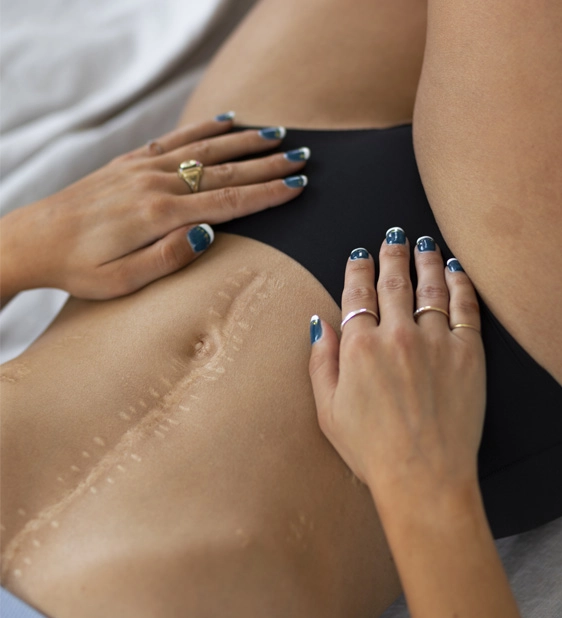What is a Scar Revision?
Scar revision is a cosmetic procedure designed to minimize or improve the appearance of scars, bringing them closer to the surrounding skin tone and texture. This procedure, often referred to as scar removal surgery or surgical scar removal, involves various techniques tailored to the type of scar being treated. Scar revision can include surgical scar excision, where the scar tissue is carefully removed and the skin is re-sutured or less invasive methods such as laser treatments, dermabrasion or chemical peels. The goal of scar surgery is not just to reduce the visibility of the scar but also to restore functionality in cases where scar tissue causes restriction. Performed by skilled surgeons, such as those at V for Aesthetics in Turkey, scar revision can significantly enhance the aesthetic appearance and confidence of individuals affected by scarring.

Are You a Suitable Candidate for Scar Revision?
Determining if you are a suitable candidate for scar revision involves evaluating the type, size, and maturity of the scar, as well as the overall skin health. Ideal candidates for scar removal surgery are individuals with scars that are noticeable, cause discomfort or self-consciousness, and have not improved with non-surgical treatments. Surgical scar excision or scar surgery is often recommended for scars that result from injuries, surgeries or burns that have healed but left significant visible marks.
Candidates should be in good general health, have no active skin diseases or infections in the scar area, and should not smoke, as smoking can hinder the healing process. It’s also important for candidates to have realistic expectations about the outcomes of scar revision. While scar revision can greatly improve the appearance of a scar, it’s important to understand that no scar can be completely removed. Consulting with a skilled surgeon, like those at V for Aesthetics in Turkey, is crucial to assess your specific case and to determine the most effective treatment approach for your scar revision.
Benefits of Scar Revision?
Scar revision offers numerous benefits to individuals seeking to improve the appearance of their scars through surgical scar removal or other scar revision techniques. One of the primary benefits is the enhanced appearance of the skin, as scar revision aims to make the scar less noticeable and more consistent with the surrounding skin tone and texture. This can lead to increased self-confidence and a positive impact on self-esteem, especially for those who have been self-conscious about their scars.
Another significant benefit of scar revision, particularly in cases of surgical scar excision, is the improvement in comfort and functionality. Some scars, especially those that are tight or large, can restrict movement or cause discomfort. Scar revision surgery can alleviate these issues, allowing for greater freedom of movement and relief from discomfort.
Scar revision also helps in correcting disfigurements that result from injuries, burns or previous surgeries, providing a more aesthetically pleasing appearance. Additionally, in cases where scars have caused emotional distress, scar revision can offer psychological benefits, helping individuals to move past traumatic events linked to the scarring.
How common is Scar Revision?
Scar revision is a relatively common procedure in the field of cosmetic and reconstructive surgery. Its prevalence is due to the fact that scarring is a natural part of the healing process after an injury or surgery, and many individuals are left with scars that are visually noticeable or cause physical discomfort.
The demand for scar revision arises not only for cosmetic reasons but also for functional ones, especially when scars lead to restricted movement or discomfort. Advances in surgical techniques and technology have made scar revision more accessible and effective, leading to its increased popularity.
Scar revision techniques, including surgical scar removal and non-surgical treatments, are sought after by individuals wanting to improve the appearance of scars from accidents, surgeries, burns or other injuries. The accessibility of these treatments varies, but with the growing emphasis on aesthetic medicine and the availability of skilled surgeons, more people are opting for scar revision to enhance their appearance and quality of life.
How to Prepare for a Scar Revision?
Preparing for a scar revision, whether it involves surgical scar removal or other techniques, requires careful planning and adherence to pre-operative guidelines. Firstly, a thorough consultation with your surgeon is essential to understand the specifics of your scar revision procedure. During this meeting, discuss your medical history, current medications, and expectations.
You may be advised to cease smoking well in advance of the surgery, as smoking can significantly affect the healing process. It’s also crucial to avoid certain medications and supplements that can increase bleeding risk, like aspirin, anti-inflammatory drugs, and certain herbal supplements.
Ensuring you have a comfortable recovery area set up at home is important. This includes having necessary items within easy reach and arranging for someone to assist you in the first few days following the procedure if needed.
Follow any specific instructions given by your surgeon regarding eating, drinking, and medication adjustments in the days leading up to the surgery. It’s also advisable to arrange transportation to and from the clinic, as you will not be able to drive immediately after the procedure.
Scar Revision Surgical Process
The surgical process for scar revision varies depending on the type and severity of the scar being treated. Generally, the procedure begins with the administration of anesthesia, which may be local or general, based on the extent of the scar revision.
In the case of surgical scar excision, the surgeon carefully removes the scar tissue, then closes the incision using advanced techniques to minimize new scar formation. For certain types of scars, other techniques such as laser therapy, dermabrasion or chemical peels might be used to improve the texture and appearance of the scar.
The specific method chosen depends on various factors, including the scar’s size, location, and depth, as well as the patient’s skin type and overall health. The goal of the scar revision process is to create a less noticeable scar and improve the overall appearance of the skin.
This procedure can vary in duration depending on the complexity of the scar and the technique used. After the procedure, patients are typically taken to a recovery area where they are closely monitored as they wake up from anesthesia.
The skill and experience of the surgeon, especially in delicate procedures like scar revision, play a crucial role in achieving the best possible outcome.
Scar Revision Recovery: What to Expect
After undergoing a scar revision, which can include surgical scar removal or surgical scar excision, patients can expect a recovery period where proper care is essential for optimal healing. The immediate aftermath of the scar surgery might involve some swelling, redness, and discomfort at the treatment site. These symptoms are generally manageable and will gradually improve over the days following the surgery.
Post-operative care instructions provided by your surgeon, often specific to the type of scar surgery performed, are crucial and should be followed diligently. This care may include cleaning the incision site, applying prescribed ointments, and changing dressings.
The recovery time can vary based on the extent of the scar revision surgery and the individual’s overall health. Most patients are able to resume normal activities within a few days to a week, but strenuous activities should be avoided until the site is fully healed.
The final appearance of the scar post-revision will evolve over several months. While some improvements will be noticeable immediately, the complete healing process, where the scar becomes flatter and lighter, can take up to a year.
Risks of Scar Revision
While scar revision, including surgical scar removal and surgical scar excision, is generally safe, there are inherent risks as with any surgery. Common risks include infection, bleeding, and adverse reactions to anesthesia. Specific risks related to scar revision surgery include the possibility that the new scar may not represent a significant improvement over the original scar or could potentially become more pronounced.
Other potential risks include changes in skin sensation around the scar, poor wound healing, and the development of keloids or hypertrophic scars, particularly in individuals prone to these conditions. As with any surgical procedure, individuals who smoke or have certain health conditions may face increased risks.
It is important for patients considering scar revision surgery to discuss these risks thoroughly with their surgeon. Understanding these risks and following pre- and post-operative care instructions carefully can help minimize complications and ensure a more successful outcome.
Maintaining Long-Term Results: Post-Scar Revision Care
To maintain the long-term results of a scar revision, which can include surgical scar removal or surgical scar excision, proper post-operative care is crucial. This involves following your surgeon’s specific instructions regarding wound care, which typically includes keeping the area clean and applying any prescribed ointments or creams.
Protecting the revised scar from sun exposure is essential, as UV rays can darken the scar and affect its appearance. Using sunscreen on the scarred area when outdoors can help prevent this. Additionally, patients are often advised to avoid strenuous activities that might stretch the skin and interfere with healing.
For optimal results, maintaining a healthy lifestyle, including proper nutrition and hydration, is also important. It supports the body’s natural healing process and can enhance the appearance of the skin.
Regular follow-up visits with your surgeon are recommended to monitor the healing process and to address any concerns that may arise. By adhering to these post-scar revision care steps, patients can significantly improve and maintain the appearance of their scars.
Results of the Scar Revision Permanent?
The results of a scar revision are generally long-lasting, but it’s important to have realistic expectations. While surgical scar removal and surgical scar excision can significantly improve the appearance of a scar, making it less noticeable, it’s rare for a scar to disappear completely.
The permanence of scar revision results can also be influenced by factors such as the body’s natural healing process, the original scar’s characteristics, and how well post-operative care guidelines are followed. In some cases, scars may require additional treatments or revisions for optimal results.
Understanding that scar revision aims to improve rather than erase a scar is crucial for patient satisfaction. The improved appearance of a scar following revision surgery is typically a permanent change, although it may take several months to a year for the final results to fully mature.
Is Scar Revision Painful?
The experience of pain with scar revision, including procedures like surgical scar removal or excision, can vary depending on the individual’s pain tolerance and the specific nature of the scar surgery. During the scar revision procedure itself, patients are typically under anesthesia, which can be either local or general depending on the extent of the surgery. This ensures that there is no pain experienced during the procedure itself.
After the surgery, it’s normal for patients to experience some degree of discomfort, swelling, and tenderness in the area where the scar revision was performed. The level of postoperative pain is generally mild to moderate and can be effectively managed with prescribed pain medications. The intensity and duration of pain will depend on the extent of the scar revision, the techniques used, and the patient’s individual healing process.
It’s important for patients to follow their surgeon’s post-operative care instructions, including taking prescribed medications, properly caring for the wound, and avoiding certain activities that might strain the healing tissue. These measures help in minimizing discomfort and facilitating a smoother recovery process.
Overall, while some discomfort is expected after scar revision surgery, it is typically manageable and temporary, subsiding as the healing process advances.
Scar Revision Prices
When considering scar revision, understanding the scar revision prices is an important aspect for patients. The cost of scar revision can vary widely, depending on several factors such as the complexity of the scar, the specific techniques used in the surgery, and the geographic location of the clinic. At V for Aesthetics in Turkey, the scar revision prices are set to offer a balance between quality service and affordability. The total cost may encompass various aspects of the procedure, including the surgeon’s fees, facility costs, anesthesia, and any additional treatments that might be required as part of the scar revision process.
Patients interested in scar revision should consider getting a detailed quote to understand all the costs involved. While scar revision prices are an important consideration, it’s equally crucial to choose a clinic and surgeon based on their expertise and experience in scar surgery to ensure the best possible outcome.

Scar Revision in Turkey
Scar revision in Turkey has become an increasingly popular option for those seeking high-quality and affordable surgical treatments. Known for its advanced medical facilities and experienced surgeons, such as those at V for Aesthetics, Turkey offers excellent services in cosmetic and reconstructive surgeries, including scar revision. Opting for scar revision in Turkey can be particularly advantageous due to the lower costs compared to many other countries, without compromising on the quality of care and results. The surgeons in Turkey are well-versed in the latest techniques of scar surgery, ensuring that patients receive the most effective treatment for their specific scar types. Moreover, undergoing scar revision in Turkey allows patients to recover in a culturally rich and welcoming environment, adding a unique aspect to their medical journey. With its combination of skilled medical professionals, cutting-edge technology, and competitive pricing, Turkey is a leading destination for patients seeking scar revision.
Scar Revision Near Me
For those looking to undergo scar revision, finding a reputable clinic nearby is often a top priority. Conducting a search for ‘scar revision near me’ can lead to a variety of options, including esteemed clinics like V for Aesthetics in Turkey. When searching for ‘scar revision near me’, it’s crucial to evaluate the clinic’s and surgeon’s expertise in scar surgery, their track record, and patient reviews. A clinic that frequently appears in searches for ‘scar revision near me’, such as V for Aesthetics, often offers a combination of expert care, state-of-the-art facilities, and a patient-focused approach.
Scheduling a consultation with a clinic found through a ‘scar revision near me’ search is advisable to discuss the specific needs, understand the proposed treatment plan, and establish realistic expectations. Choosing the right clinic for scar revision, one that combines proximity with high-quality care, can greatly influence the effectiveness and satisfaction with the overall treatment outcome.
For More Information
Please do not hesitate to contact us for more information on the subject.
